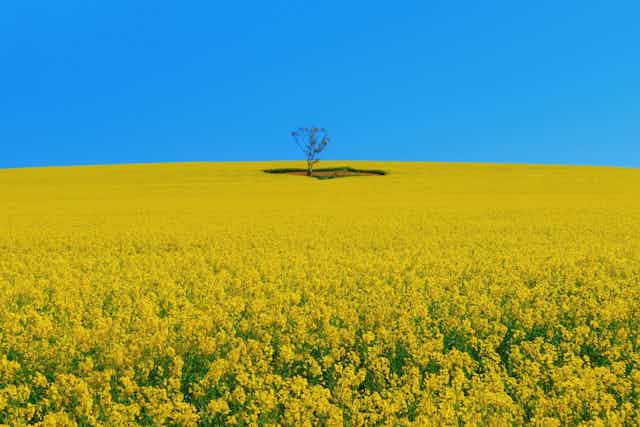Rolling plains of wheat, endless fields of flowering canola, row upon row of fruit trees: these agricultural landscapes are the stuff of stunning photographs.
Filling these paddocks with just one crop, known as monoculture, is a relatively easy, common and efficient way to produce food and fibre.
But international research shows that these monocultures can be bad for the environment and production through effects on soil quality, erosion, plants and animals, and ultimately declining crop yields. Research I have published this week in the International Journal of Agricultural Sustainability shows a possible link between monoculture landscapes and fewer wild pollinators.
Is there a better way to grow our food?
Bad for the environment, bad for us
Monocultures don’t exist in nature. Natural ecosystems that appear to be dominated by one plant or tree species (such as grasslands or some temperate forests) also have many other plant species growing under and around them.
This diversity of plant species and sizes supports diverse wildlife communities, and this diversity supports ecosystem services such as pollination and biological control.
When this diversity disappears, the results can be disastrous. The Dust Bowl years on the American Great Plains showed us what can happen when natural ecosystems are overwhelmed by intensive, single-crop farming.
The problem with orchards

My research focuses particularly on almond orchards. Large fruit tree plantations differ from field crops because they are permanently embedded in the landscape for more than 10 years. Therefore, they may have more serious, long-term impacts on the environment than an annual crop.
If a plantation is inhospitable to an animal species, it won’t be able to move through the plantation to find food or shelter. This essentially creates a landscape barrier for that species.
Such effects have been found on bird, ground beetle, reptile and marsupial species living in landscapes dominated by pine plantations in south-eastern Australia.
Unlike pine trees, fruit trees rely on insect pollination, an ecosystem service, to produce fruit. But very little research has looked out how plantations of fruit trees might affect the ecosystems around them, and in turn the pollinators that the fruit trees depend on. With all the agricultural stressors influencing honey bee colony losses in other parts of the world, understanding how wild pollinators respond to farming practices is critical.
In the mallee woodlands and shrublands of southern Australia, probably one of the most understudied and important ecosystems for conservation, almond plantations are rapidly expanding.

Complexity is the key
Research from California on commercial almond plantations shows that numbers of wild pollinator and parasitoid insects (unmanaged insects that enhance yields through pollination and biological control) increased with plant diversity.
My PhD research has found similar effects in north western Victoria: there were more pollinators where there were more types of plants.
What does this diversity mean? Monoculture crops are intensively managed to remove as many plants that aren’t crops as possible. In the middle of a monoculture almond plantation, for instance, you will see little else but almond trees and bare soil for hundreds of hectares around you.
In the new paper, I found a possible link between more wild pollinators and more complex landscapes.

In a “simple” landscape dominated by multiple monoculture almond plantations, native bees and hoverflies (both important pollinator groups) were only found near almond trees within 100 metres of native mallee vegetation.
In contrast, in a “complex” agricultural landscape made up of small mosaic patches of many different crops, gardens and remnant native vegetation, native bees and hoverflies were found at almond trees further than 100 metres from native vegetation.
The critical difference was the diversity of resources available to wild pollinators throughout the year. In “complex” landscapes food, water and nesting resources were all available to pollinators within their typical home range (usually less than 1-2 km).
Making farming more sustainable
A sustainable farm isn’t just efficient to manage or designed to produce maximum yields per hectare. It also depends on conservation of biodiversity, ecosystem function and diversification of crops and/or livestock.
Maintaining biodiversity in plantations supports important ecosystem services that can increase yields, such as unmanaged pollination, biological control and waste disposal services. This agroecological approach to food production minimises risks through stable yields and limited resource use. It is good for the farmer and the environment.
Research and development of agroecological systems are now internationally recognised as vital to sustainable food and fibre production. France recently incorporated agroecology into their legal and political frameworks, while academic institutions in the UK and USA are leading the way with ground-breaking research into ecologically-sustainable agriculture.
With our unique natural environment and strong agricultural communities, Australia is uniquely-placed to contribute to the global discussion on sustainable agriculture.

